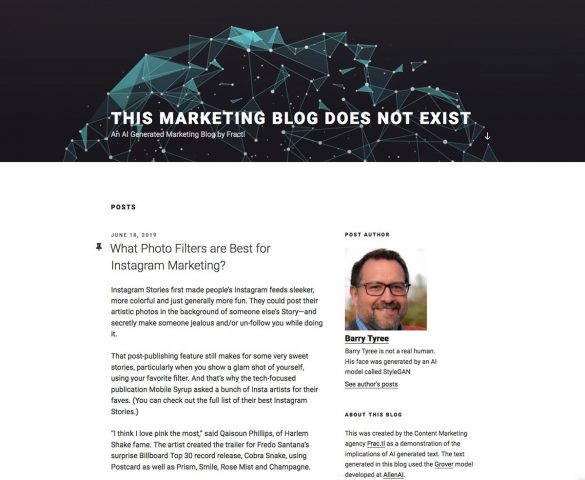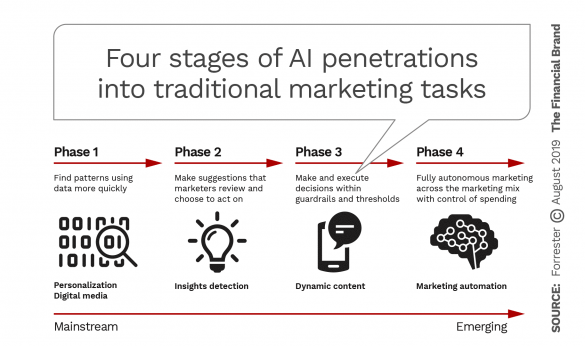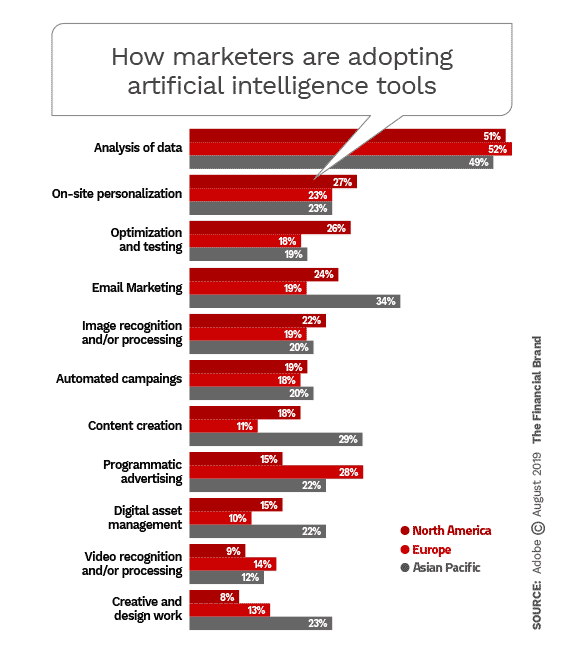Financial marketers have to crank out a lot of content — blogs, ad copy, social media posts, web content, and more.
Everyone grinding out content would like to have more help. Would you hire the writer who put together the following paragraph on Search Engine Optimization?
“You should think about AI as a smart, efficient and inspirational assistant.”
— Thomas Husson, Forrester
“Search engine marketers find and rank on websites by making sure they have content relevant to other visitors. In order to have useful content, try clicking on links in a newspaper, magazine, book or website. Do that, and now you will have found good links in other sites that you would now like to link to in a future article. To promote it more, list it in your blog, which will then promote it much more on the web.”
Not Pulitzer material, but more or less intelligible. Want to hire the blogger who produced it?
You can’t.
He doesn’t exist. The copy is the creation of an artificial intelligence model called Grover, which the content marketing agency Fractl used to make some points about the potential use of AI on content writing and search optimization. The blog is called “This Marketing Blog Does Not Exist.”
This isn’t an isolated instance by any means.
PwC’s Industry Cloud for Banking applies our deep industry knowledge to your specific business needs Build a modern credit card strategy that balances profitability and risk, adopts the latest technology and delivers the customization that cardholders demand. Read More about Navigating Credit Card Issuing in an Uncertain Economic Environment

Industry Cloud for Banking from PwC

Navigating Credit Card Issuing in an Uncertain Economic Environment
What’s Out There that AI is Writing
Once the stuff of science fiction, AI was actually used to produce a short sci fi film in 2016, called, “Sunspring.” It’s borderline gibberish, but did demonstrate the potential. Since then, several successful uses of AI to create content creator have already been implemented.
- Associated Press has tapped AI to produce certain kinds of news updates. AP publishes over 4,000 corporate earnings report articles every quarter now, using AI. Previously human staff could pump out only around 300 stories per quarter.
- The Washington Post uses AI called Heliograf to write certain articles, such as reports on high school sports.
- In the U.K. “RADAR” — for Reporters and Data and Robots — funded by Google’s Digital News Initiative, turns massive government statistical reports into local articles using templates created by human journalists.

A scene from “Sunspring,” a short sci-fi film written by a piece of artificial intelligence software on a smartphone that was retasked to write movie scripts. The film is a dystopian flop, but it is the first effort of “Benjamin,” the name the AI gave itself.
These developments answer the question, “Can AI write content?” But what should really put content creation by AI on the map for banks and credit unions was the announcement that JPMorgan Chase has agreed to a five-year deal with AI marketing firm Persado to produce marketing content.
“Machine learning is the path to more humanity in marketing,” says Kristin Lemkau, CMO at JPMorgan Chase. This may sound a bit paradoxical, but Lemkau explains that the technology devised and revised copy and headlines “that a marketer, using subject judgment and their experience, likely wouldn’t have. And they worked.”
Read More:
- JPMorgan Chase CMO Says You Can Kiss Traditional Marketing Goodbye
- Banking Can No Longer Ignore The Power of AI
- Artificial Intelligence: The Financial Marketer’s Secret Weapon
What Does AI ‘Writing Content’ Actually Mean?
Talking about AI producing advertising copy begets mental images of C-3PO sitting at a manual typewriter, stogie in mouth, batting out jingles and slogans on an Underwood. Not quite what’s involved.
“It’s more about augmenting creativity of humans, maintains Thomas Husson, Vice President and Principal Analyst at Forrester. “There are opportunities emerging to tap data-driven creativity for more marketing results.”
Husson believes pulling AI further into the content creation process reflects a natural progression in the use of AI in marketing. It is already used for tasks like media buying and in handling personalization. Chase, Citi, Coca Cola, and Toyota, AI has encroached further into content creation and tailoring.
Now it’s being used by Chase, Citi, Coca Cola and Toyota to produce material that has been adjusted to micro segments and micro targets.
“The question has been, what will be the impact on creativity?” says Husson.
There have been attempts to match human creative against AI, he says. In one celebrated face-off in Japan, an effort by a human creative director won more votes from Japanese consumers than did creative produced by AI.
But Husson thinks such thinking clouds the real potential for AI in content creation by casting things in an either/or light. He thinks combining the best of human creativity with the things that AI really does well is the future, at least for now.
“The challenge has been to stop thinking about jobs, and the fear of losing jobs, and think instead about tasks, and the tasks that AI is better equipped to perform. At the end of the day, you should think about AI as a smart, efficient and inspirational assistant,” Husson insists.
For example, by sheer computing power, AI can enable personalization of marketing messages at scale, says Husson.
Read More:
- AI Could Destroy Traditional Banking As We Know It
- How BankMobile Uses Artificial Intelligence to Streamline the Experience

Where Should AI Be Applied in Content Process?
AI should be automating tasks that lend themselves to repetitive or structured operations, Husson continues. Taking this away from the humans does not put them out of work, but upgrades their work to things machines can’t do — setting marketing content strategy and finding ways to inject emotion into marketing, for example.
“Suddenly everybody’s an art director and everybody’s a copywriter, and when marketing creativity amounts to guesswork, everybody in the room feels they have the right answer.”
— Van Diamandakis, Persado
What does this look like?
AI can participate in content creation in several major ways. “To start combining AI and creativity, focus on content intelligence and select the most emotive language,” says Husson. He defines “content intelligence” as “the use of artificial intelligence technologies to understand and capture the qualities inherent in any content — its emotional appeal, subject matter, style, tone, or sentiment.”
The technology that Chase is using is provided by Persado. Van Diamandakis, CMO, speaks of AI as bringing the best of humanity back into banking by re-introducing the focus when most banking was a local business and experienced staff knew all about their institution’s customers.
“It’s all about how we can take the guesswork out of creativity to make it more authentic and human again, but at scale,” says Diamandakis.
He points out a common situation that should be familiar to nearly every bank and credit union marketer. The key players meet with Marketing about a campaign, and … “Suddenly everybody’s an art director and everybody’s a copywriter, and when marketing creativity amounts to guesswork, everybody in the room feels they have the right answer.” AI has no ax to grind, no “opinion,” and has access to more data than people have.
Persado attempts to take messages and craft them for maximum impact by drawing on its databases to use the most effective terms. Six factors go into messaging derived in this way:
- Narrative — a description of how the consumer’s life will improve.
- Emotional — something about the potential that makes this “awesome news.”
- Descriptive — something with appeal as a hook.
- Call to Action — a reason to act now.
- Formatting — bold type, italicization, and today, the effective placement and choice of emojis.
- Positioning — how to best arrange all the other elements for maximum impact.
The idea is to use AI to combine past performance of terms and phrases with testing that goes far beyond A/B evaluation. This takes the crafting and refining of content away from guesswork and closer to precision. In other words: Marry data analytics to content creation.
“AI can help pick the right product offer, the right call to action, and the right emotion to use,” says Diamandakis. “And it might differ across channels.”
A very narrow AI content application is generating ideal subject lines for emails. AI can also help a bank or credit union achieve a uniform tone or style in its marketing and other internal and external communications with enterprise-wide systems that review all messaging from a common set of guidelines. This can help enforce branding priorities.

Are You Ready for a Digital Transformation?
Unlock the potential of your financial institution's digital future with Arriba Advisors. Chart a course for growth, value and superior customer experiences.

Fractional Marketing for Financial Brands
Services that scale with you.
Steps to Take When Considering Implementation
Paul Roetzer, Founder at the Marketing AI Institute and head of PR2020 has four suggestions for institutions that are considering adding AI to their content arsenal:
1. Evaluate your content efforts and single out repetitive, manual marketing tasks. These are the best candidates for AI initially. They are what’s chewing up Marketing’s time. The institution may already have AI in existing systems that can help. At the least this will identify the kind of outside help to seek.
2. Assess opportunities to get more out of your data. Consumer banking produces too much data to exploit with just a brain and Excel spreadsheets. “How can you get more out of your data, how can you tell better stories, and how can you produce better outcomes?” says Roetzer.
3. Shop carefully for more AI based on what you already have. The AI marketing business is full of startups, and startups tend to get acquired. If the institution has a sizeable martech investment already, it may make sense to look at tapping one of those vendors (if they have the capability), rather than pick and choose among startups that may move further away from your existing tech.
4. And a reality check: There’s no set it and forget it. Even if your financial institution wanted to turn over content to a robot, such tech doesn’t exist yet.
“There is no such thing as a completely autonomous AI tool for marketing on the market today,” says Roetzer.









